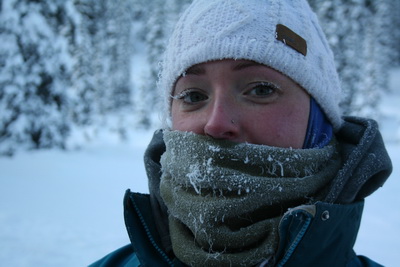Over the years we have run field sessions in all types of crazy weather. It is rare that we have perfect weather on a field day.
The pictures in this article were all take when the temperature was -28C. Brr!

Sometimes we are in the bitter cold, usually in the wind with snow puking down, but the worst is when it rains. It is a bit of a gamble to pre-register for any event in life. Unfortunately this is a reality that we deal with in most of our business and personal activities.
Part of an avalanche safety course is to prepare backcountry users to deal with their environment. Accidents usually happen in less than ideal conditions and we need to know how to be prepared and function in stressful and uncomfortable conditions.
(Scroll down for some ideas on how to prepare for mountain conditions.)
**In order to ensure top quality avalanche instructors and resources it is necessary to guarantee working days. Based on the registrations we do the best we can to accommodate students and instructors needs. As well, there are other non-refundable expenses that are pre-arranged in order to hold these field dates. We hope that everyone can understand. These economic realities have demanded that we institute a cancellation policy. Please review it by clicking this link. Cancellation Policy**

During the field dates we make every effort to keep the participants comfortable. We choose riding areas with a grooming program, trees and access to heated cabins for emergencies. If necessary, the field session locations and order of exercises are modified to minimize weather influences.
In addition, we usually pull a large toboggan and can EASILY PACK IN ANY EXTRA GEAR THAT YOU MAY REQUIRE.
HINTS FOR THE COLD:
- Loose fitting boots
- Thick soles to get your feet off the snow
- Boots with multiple REMOVABLE liners work well. Rated for -40 if available. Removable liners allow you to completely dry out the entire boot. Please leave the Klim or Motorfist style boots in your gear bag. Pull out the Sorel or Baffin type boots a pipeline worker or an ice fisherman might wear to stand outside all day in frigid temperatures. Even chore boots designed for the farm with extra liners under the foot will be warmer than traditional snowmobile boots.
 Thermal socks (Socks that are designed to wick the moisture from your feet and insulate as well.) Loose fitting.
Thermal socks (Socks that are designed to wick the moisture from your feet and insulate as well.) Loose fitting.- Gloves that are windproof as well as warm. We sometimes duct-tape the backside of the gloves to keep out the wind.
- Ensure that the electric hand warmers are working on your sled
- Use the small (chemical) handwarmers inside gloves and boots.
- Wear the full face helmet instead of the motorcross helmet with goggles.
- Use the breath guard to protect your face from frostbite
- Make sure all goggle vents and clothing vents are closed. Duct-tape the vents that can’t be closed.
- Use duct tape on the inside of the mouth piece of a motorcross helmet. It works well and is not visible.
- To keep the goggles free of frost, drop the visor or put on the goggles as the LAST thing that you do before moving your sled
- Pop the visor or goggles off immediately after stopping. Without the air movement your breath tends to freeze to the lenses…no fun.
- Try to use a balaclava that is made of a fleece type material rather than a silky one.
- Ensure that your neck is well protected.

- Bring Mitts in case the gloves are too chilly.
- Wear layers of loose fitting clothing.
- Wear warm clothing rather than fashionable stuff. No one cares if it matches!!
- Bring extra layers just in case.
- Down jackets are extremely warm, lightweight and flexible and should be in your pack as a back-up on every riding day.
- Bring hot drinks
- Eat high energy and high protein foods to keep the body building heat. (Nuts, cheese, meat, energy bars, big breakfast…)
HINTS FOR THE RAIN
- Bring a large plastic bag to shield your backpack
- Wear waterproof and breathable clothing (Goretex, E-vent…) Be sure to always wash all specialty fabrics with the correct detergent for the products. Regular laundry soap will not maintain the breathability of the fabrics. Most of the time when we are wet it isn’t because the water leaked it, it is because the pores in our clothing are plugged and our inner moisture cannot get out.
- Duct-tape or use gaitors to bind your pantlegs to your boots so that they don’t collect as much snow that will melt into your clothing
- Wear waterproof boots. (A not so wonderful solution, but a quick fix is to put plastic bags over your liners in boots that are not fully waterproof.)
- Bring extra gear to change into for the ride back to the trucks
- Use the ‘waterproof/breathable’ spray on products if it is designed for your clothing
HINTS FOR THE SUN
People are often surprised at the strength of the sun on a winter’s day. We are working on the snow which is a serious reflector of the sunlight.
- wear good sunglasses, polarized if possible
- wear sunscreen and reapply throughout the day
- ensure that your goggles have some degree of UV protection
HINTS FOR THE WIND
See the section about the cold
HINTS FOR SNOWY DAYS
See the section about the cold and the rain.
